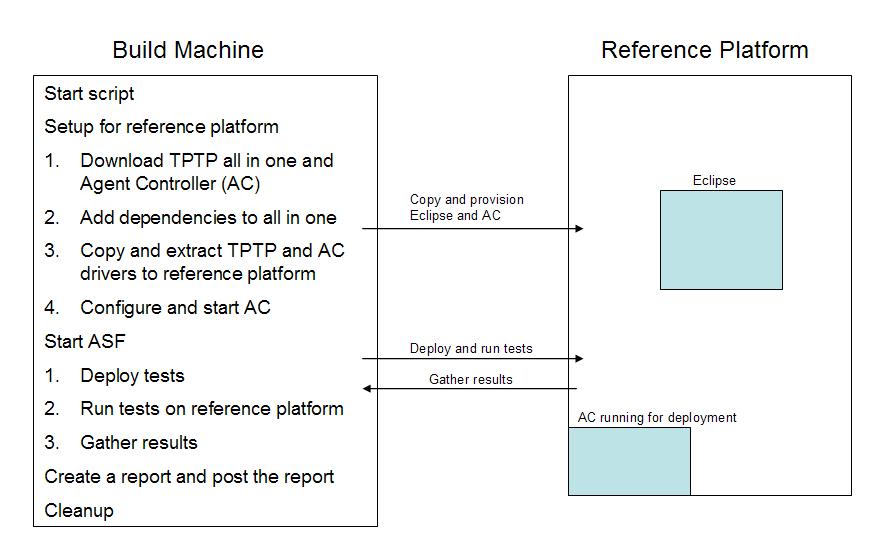Notice: This Wiki is now read only and edits are no longer possible. Please see: https://gitlab.eclipse.org/eclipsefdn/helpdesk/-/wikis/Wiki-shutdown-plan for the plan.
Difference between revisions of "4.5 Test Automation Initiative"
(→Meeting Minutes) |
(→Testing Process) |
||
| Line 46: | Line 46: | ||
== Testing Process == | == Testing Process == | ||
| − | * Part 1: | + | * A very lightweight testing process for TPTP. |
| + | * Extends the existing TPTP Testing Strategy. | ||
| + | * Considered as a instruction manual (e.g. step-by-step) for testing TPTP for each type of testing scenario. | ||
| + | * Two (or more) documents: | ||
| + | ** 1) High steps to use the testing infrastructure intended for first time users. This document will reference the other document(s). | ||
| + | ** 2) Low level detailed discussion on the motivation and design of the infrastructure intended for TPTP adopters or extenders. | ||
| + | ** 3) Additional documents detailing the specifics of a testing topics. | ||
| + | |||
| + | * Discussion: | ||
| + | ** Naming conventions for root level test suites and execution results should include test plug-in ID. | ||
| + | ** Execution results need to be saved in a directory with a meaningful name (e.g. OS, JRE, type (full, smoke, BVT)). | ||
| + | ** Test suites for specific JREs and OSes (e.g. JVMPI versus JVMTI) will not always run on the reference platform(s). | ||
| + | ** The existing technical content will remain unchanged, aside from review changes. | ||
| + | ** Need sections for: | ||
| + | *** Getting tests. | ||
| + | *** Creating tests. | ||
| + | *** Running tests. | ||
| + | *** Save test results. | ||
| + | *** Reporting results. | ||
| + | *** BVTs. | ||
| + | ** The Agent Controller and profiler test suites need to migrated to use the TPTP Test Tools instead of requiring a custom configuration. | ||
| + | ** The average tester/reader does not need to know about the technical details, but the steps to perform a certain testing task. | ||
| + | |||
| + | |||
| + | * '''Draft Documents''' | ||
| + | ** Part 1: | ||
** [http://www.eclipse.org/tptp/home/documents/process/test/automation/process/TPTP_Testing_Strategy_Part_1_Draft_1.doc Draft 1]: [[Testing Process Part 1 Draft 1 Comments| Comments]] | ** [http://www.eclipse.org/tptp/home/documents/process/test/automation/process/TPTP_Testing_Strategy_Part_1_Draft_1.doc Draft 1]: [[Testing Process Part 1 Draft 1 Comments| Comments]] | ||
Revision as of 13:03, 19 November 2007
Contents
Members
- Paul Slauenwhite (IBM)
- Alan Haggarty (IBM)
- Joel Cayne (IBM)
- Jonathan West (IBM)
- Joanna Kubasta (IBM)
- Kiryl Kazakevich (Intel)
Goals
- Consolidation of our testing process and infrastructure.
- Consolidation of custom test frameworks (Test Dashboard, AC/Profiler test server, variants).
- Reuse of Test Project framework (ASF, reporting, etc.) and tools (AGR, JUnit, etc.).
- Automatic test execution and report generation with every build (BVT).
- Integrate EMMA with the build and test process for generating code coverage reports for all manual and automated testing.
Benefits
- Specialization of testing skills (e.g. builds).
- Provide an infrastructure that makes it easy for committers to contribute automated test cases/suites.
- Manual labor savings by using automated tests, which are automatically executed with every build.
- Decrease time/cost to resolve defects since uncovered earlier in the code-test-build cycle.
- Decrease testing overlap by a) localizing test executing and reporting to one group and b) using code coverage statistics.
Delivery dates
- November 14:
- First draft of the first testing process document for review.
- Proof of concept (PoC) for integration of ASF and TPTP builds for PMC approval and integrate with TPTP builds.
- Status update for the PMC.
- Measure cost savings.
- November 21:
- Review of the first testing process document.
- First draft of the remaining testing process documents for review
- Identify and resolve bugs.
- November 28:
- Final version of the the first testing process document.
- Review of the remaining testing process documents for review
- Status update including cost savings for the PMC.
- Presentation to TPTP committers.
- Each project automates their manual test suites and converge existing automated test suites over time to leverage the test infrastructure.
Testing Process
- A very lightweight testing process for TPTP.
- Extends the existing TPTP Testing Strategy.
- Considered as a instruction manual (e.g. step-by-step) for testing TPTP for each type of testing scenario.
- Two (or more) documents:
- 1) High steps to use the testing infrastructure intended for first time users. This document will reference the other document(s).
- 2) Low level detailed discussion on the motivation and design of the infrastructure intended for TPTP adopters or extenders.
- 3) Additional documents detailing the specifics of a testing topics.
- Discussion:
- Naming conventions for root level test suites and execution results should include test plug-in ID.
- Execution results need to be saved in a directory with a meaningful name (e.g. OS, JRE, type (full, smoke, BVT)).
- Test suites for specific JREs and OSes (e.g. JVMPI versus JVMTI) will not always run on the reference platform(s).
- The existing technical content will remain unchanged, aside from review changes.
- Need sections for:
- Getting tests.
- Creating tests.
- Running tests.
- Save test results.
- Reporting results.
- BVTs.
- The Agent Controller and profiler test suites need to migrated to use the TPTP Test Tools instead of requiring a custom configuration.
- The average tester/reader does not need to know about the technical details, but the steps to perform a certain testing task.
Common Test Infrastructure
- Demonstration viewlet.
- Diagram detailing the architecture:

